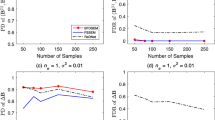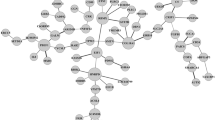Abstract
A gene regulatory networks (GRN) is composed of a set of genes as well as the regulatory relationships between them. Under different conditions, GRNs with the same gene set usually have similar but not exactly the same structure. The differential analysis of GRNs under different conditions is of great significance to understand gene functions and biological mechanisms. In a naive approach, GRNs under different conditions can be separately inferred via existing GRN inference algorithms, and then the difference between them can be identified by comparing the estimated structures. However, such an approach does not consider the commonality of the pairwise GRNs, which may decrease the predictive accuracy of the differential GRN. In this paper, we model GRNs with the structural equation models (SEMs) to integrate gene expression data and genetic perturbations, and propose a joint differential analysis algorithm named differential sparse SEM (DiffSSEM) to identify the topology structures of GRNs under different conditions as well as the difference between them. The DiffSSEM algorithm simultaneously consider the sparsity of separate GRNs and differential GRN. Simulations were run on synthetic data and the results demonstrated that the DiffSSEM algorithm outperforms the naive approach based on a state-of-the-art sparse SEM inference algorithm. Finally, a real data set of 15 lung genes from 42 tumor tissues and normal tissues was analyzed with the DiffSSEM algorithm to identify the differential GRN.








Similar content being viewed by others
References
Akutsu T, Miyano S, Kuhara S (2000) Algorithms for identifying boolean networks and related biological networks based on matrix multiplication and fingerprint function. J Comput Biol 7(3–4):331–343
Bansal M, Belcastro V (2007) How to infer gene networks from expression profiles. Mol Syst Biol 3(1):78
Basso K, Margolin AA, Stolovizky G, Klein U, Dallafavera R, Califano A (2005) Reverse engineering of regulatory networks in human b cells. Nat Genet 37(4):382–390
Brazhnik P, De LFA, Mendes P (2002) Gene networks: how to put the function in genomics. Trends Biotechnol 20(11):467–472
Butte AJ, Tamayo P, Slonim D, Golub TR, Kohane IS (2000) Discovering functional relationships between RNA expression and chemotherapeutic susceptibility using relevance networks. P Natl Acad Sci USA 97(22):12182–12186
Cai X, Andrés BJ, Giannakis GB (2013) Inference of gene regulatory networks with sparse structural equation models exploiting genetic perturbations. PloS Comput Bio 9(5):e1003068
Chen C, Ren M, Zhang M, Zhang D (2018) A two-stage penalized least squares method for constructing large systems of structural equations. J Mach Learn Res 19(2):40–73
Crick F (1970) Central dogma of molecular biology. Nature 227(5258):561–563
Danaher P, Wang P, Witten DM (2014) The joint graphical lasso for inverse covariance estimation across multiple classes. J R Stat Soc B 76(2):373–397
De LFA (2010) From ‘differential expression’ to ‘differential networking’ identification of dysfunctional regulatory networks in diseases. Trends Genet 26(7):326–333
Fan J, Liao Y (2014) Endogeneity in high dimensions. Ann Stat 42(3):872–917
Friedman N, Linial M, Nachman I, Pe’er D (2000) Using Bayesian networks to analyze expression data. J Comput Biol 7(3–4):601–620
Gardner TS, Bernardo DD, Lorenz D, Collins JJ (2003) Inferring genetic networks and identifying compound mode of action via expression profiling. Science 301(5629):102–105
Gautier L, Cope L, Bolstad BM, Irizarry RA (2004) Affy:analysis of affymetrix genechip data at the probe level. Bioinformatics 20(3):307–315
Golub GH, Heath M, Wahba G (1979) Generalized cross-validation as a method for choosing a good ridge parameter. Technometrics 21(2):215–223
Greene CS, Krishnan A, Wong AK et al (2015) Understanding multicellular function and disease with human tissue-specific networks. Nat Genet 47(6):569–576
Ideker T, Krogan NJ (2012) Differential network biology. Mol Syst Biol 8(1):565
Kalmus H, Beament JWL (1961) Symposia of the society for experimental biology. Biometrika 48(3–4):482
Krämer N, Schäfer J, Boulesteix AL, (2009) Regularized estimation of large-scale gene association networks using graphical gaussian models. BMC Bioinformatics 10(1):384–390
Lin W, Feng R, Li H (2015) Regularization methods for high-dimensional instrumental variables regression with an application to genetical genomics. J Am Stat Assoc 110(509):270–288
Liu B, De LFA, Hoeschele I (2008) Gene network inference via structural equation modeling in genetical genomics experiments. Genetics 178(3):1763–1776
Logsdon BA, Mezey J (2010) Gene expression network reconstruction by convex feature selection when incorporating genetic perturbations. PloS Comput Bio 6(12):e1001014
Lu TP, Lai LC, Tsai MH et al (2011) Integrated analyses of copy number variations and gene expression in lung adenocarcinoma. PLoS One 6(9):e24829
Marbach D, Costello JC, Küffner R et al (2012) Wisdom of crowds for robust gene network inference. Nat Methods 9(8):796–804
Margolin AA, Nemenman I, Basso K, Wiggins C, Stolovitzky G, Favera RD, Califano A (2006) ARACNE: An algorithm for the reconstruction of gene regulatory networks in a mammalian cellular context. BMC Bioinformatics 7(Suppl 1):7
Masood MMD, Manjula D, Sugumaran V (2018) Identification of new disease genes from protein–protein interaction network. J Ambient Intell Human Comput. https://doi.org/10.1007/s12652-018-0788-1
Mi X, Eskridge K, Wang D, Baenziger PS, Campbell BT, Gill KS, Dweikat I, Bovaird J (2010) Regression-based multi-trait qtl mapping using a structural equation model. Stat Appl Genet Mol 9(1):38
Mohan K, London P, Fazel M, Witten D, Lee SI (2014) Node-based learning of multiple gaussian graphical models. J Mach Learn Res 15(1):445–488
Pe’er D, Regev A, Elidan G, Friedman N (2001) Inferring subnetworks from perturbed expression profiles. Bioinformatics 17(Suppl 1):215–224
Rockman MV (2008) Reverse engineering the genotype-phenotype map with natural genetic variation. Nature 456(7223):738–744
Sampathkumar A, Rastogi R, Arukonda S et al (2020) An efficient hybrid methodology for detection of cancer-causing gene using CSC for micro array data. J Ambient Intell Human Comput. https://doi.org/10.1007/s12652-020-01731-7
Schäfer J, Strimmer K (2005) A shrinkage approach to large-scale covariance matrix estimation and implications for functional genomics. Stat Appl Genet Mol 4(1):32
Schaffter T, Marbach D, Floreano D (2011) Genenetweaver: in silico benchmark generation and performance profiling of network inference methods. Bioinformatics 27(16):2263–2270
Shabalin AA (2015) Matrix eQTL: ultra fast eQTL analysis via large matrix operations. Bioinformatics 28(10):1353–1358
Tegner J, Yeung MK, Hasty J, Collins JJ (2003) Reverse engineering gene networks: integrating genetic perturbations with dynamical modeling. P Natl Acad Sci USA 100(10):5944–5949
Tian D, Gu Q, Ma J (2016) Identifying gene regulatory network rewiring using latent differential graphical models. Nucleic Acids Res 44(17):e140
Tibshirani R (1996) Regression shrinkage and selection via the lasso. J R Stat Soc B 58(1):267–288
Wang C, Gao F, Giannakis GB, D’Urso G, Cai X (2019) Efficient proximal gradient algorithm for inference of differential gene networks. BMC Bioinformatics 20(1):224
Xiong M, Li J, Fang X (2004) Identification of genetic networks. Genetics 166(2):1037–1052
Zhu J, Wiener MC, Zhang C, Friedman A, Minch E, Lum PY, Sachs JR, Schadt EE (2007) Increasing the power to detect causal associations by combining genotypic and expression data in segregating populations. PloS Comput Biol 3(4):e69
Zhu Y, Zhao X, Chen Y et al (2019) Algorithm for predicting weighted protein complexes by using modularity function. J Ambient Intell Human Comput. https://doi.org/10.1007/s12652-019-01594-7
Zou H (2006) The adaptive lasso and its oracle properties. J Am Stat Assoc 101(476):1418–1429
Acknowledgements
This work was supported by the National Natural Science Foundation of China under Grant Nos. 61502198, 61572226, 61472161 and 61876069.
Author information
Authors and Affiliations
Corresponding author
Additional information
Publisher's Note
Springer Nature remains neutral with regard to jurisdictional claims in published maps and institutional affiliations.
Rights and permissions
About this article
Cite this article
Li, Y., Liu, D., Zhu, Y. et al. Differential analysis of gene regulatory networks modeled with structural equation models. J Ambient Intell Human Comput 12, 9181–9192 (2021). https://doi.org/10.1007/s12652-020-02622-7
Received:
Accepted:
Published:
Issue Date:
DOI: https://doi.org/10.1007/s12652-020-02622-7




